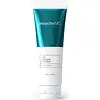What's inside
What's inside
 Key Ingredients
Key Ingredients

 Benefits
Benefits

 Concerns
Concerns

 Ingredients Side-by-side
Ingredients Side-by-side

Water
Skin ConditioningCocamidopropyl Betaine
CleansingDistearyl Phthalic Acid Amide
EmollientSynthetic Wax
AbrasiveStearyl Alcohol
EmollientCetyl Alcohol
EmollientJojoba Esters
EmollientSodium Chloride
MaskingSodium Methyl Cocoyl Taurate
CleansingCitric Acid
BufferingAloe Barbadensis Leaf Juice
Skin ConditioningCamellia Sinensis Leaf Extract
AntimicrobialCoconut Acid
CleansingMenthol
MaskingPEG-120 Methyl Glucose Dioleate
EmulsifyingCaprylyl Glycol
EmollientHexylene Glycol
EmulsifyingEthylhexylglycerin
Skin ConditioningAscorbic Acid
AntioxidantButylene Glycol
HumectantDisodium EDTA
Isopropyl Alcohol
SolventSodium Hydroxide
BufferingPhenoxyethanol
PreservativeSodium Benzoate
MaskingSodium Sulfite
PreservativePotassium Sorbate
PreservativeParfum
MaskingChromium Hydroxide Green
Water, Cocamidopropyl Betaine, Distearyl Phthalic Acid Amide, Synthetic Wax, Stearyl Alcohol, Cetyl Alcohol, Jojoba Esters, Sodium Chloride, Sodium Methyl Cocoyl Taurate, Citric Acid, Aloe Barbadensis Leaf Juice, Camellia Sinensis Leaf Extract, Coconut Acid, Menthol, PEG-120 Methyl Glucose Dioleate, Caprylyl Glycol, Hexylene Glycol, Ethylhexylglycerin, Ascorbic Acid, Butylene Glycol, Disodium EDTA, Isopropyl Alcohol, Sodium Hydroxide, Phenoxyethanol, Sodium Benzoate, Sodium Sulfite, Potassium Sorbate, Parfum, Chromium Hydroxide Green
Ingredients Explained
These ingredients are found in both products.
Ingredients higher up in an ingredient list are typically present in a larger amount.
Cetyl Alcohol is a fatty alcohol. Fatty Alcohols are most often used as an emollient or to thicken a product.
Its main roles are:
Though it has "alcohol" in the name, it is not related to denatured alcohol or ethyl alcohol.
The FDA allows products labeled "alcohol-free" to have fatty alcohols.
Learn more about Cetyl AlcoholDisodium EDTA plays a role in making products more stable by aiding other preservatives.
It is a chelating agent, meaning it neutralizes metal ions that may be found in a product.
Disodium EDTA is a salt of edetic acid and is found to be safe in cosmetic ingredients.
Learn more about Disodium EDTAParfum is a catch-all term for an ingredient or more that is used to give a scent to products.
Also called "fragrance", this ingredient can be a blend of hundreds of chemicals or plant oils. This means every product with "fragrance" or "parfum" in the ingredients list is a different mixture.
For instance, Habanolide is a proprietary trade name for a specific aroma chemical. When used as a fragrance ingredient in cosmetics, most aroma chemicals fall under the broad labeling category of “FRAGRANCE” or “PARFUM” according to EU and US regulations.
The term 'parfum' or 'fragrance' is not regulated in many countries. In many cases, it is up to the brand to define this term.
For instance, many brands choose to label themselves as "fragrance-free" because they are not using synthetic fragrances. However, their products may still contain ingredients such as essential oils that are considered a fragrance by INCI standards.
One example is Calendula flower extract. Calendula is an essential oil that still imparts a scent or 'fragrance'.
Depending on the blend, the ingredients in the mixture can cause allergies and sensitivities on the skin. Some ingredients that are known EU allergens include linalool and citronellol.
Parfum can also be used to mask or cover an unpleasant scent.
The bottom line is: not all fragrances/parfum/ingredients are created equally. If you are worried about fragrances, we recommend taking a closer look at an ingredient. And of course, we always recommend speaking with a professional.
Learn more about ParfumSodium Hydroxide is also known as lye or caustic soda. It is used to adjust the pH of products; many ingredients require a specific pH to be effective.
In small amounts, sodium hydroxide is considered safe to use. However, large amounts may cause chemical burns due to its high alkaline.
Your skin has a natural pH and acid mantle. This acid mantle helps prevent harmful bacteria from breaking through. The acid mantle also helps keep your skin hydrated.
"Alkaline" refers to a high pH level. A low pH level would be considered acidic.
Learn more about Sodium HydroxideWater. It's the most common cosmetic ingredient of all. You'll usually see it at the top of ingredient lists, meaning that it makes up the largest part of the product.
So why is it so popular? Water most often acts as a solvent - this means that it helps dissolve other ingredients into the formulation.
You'll also recognize water as that liquid we all need to stay alive. If you see this, drink a glass of water. Stay hydrated!
Learn more about Water